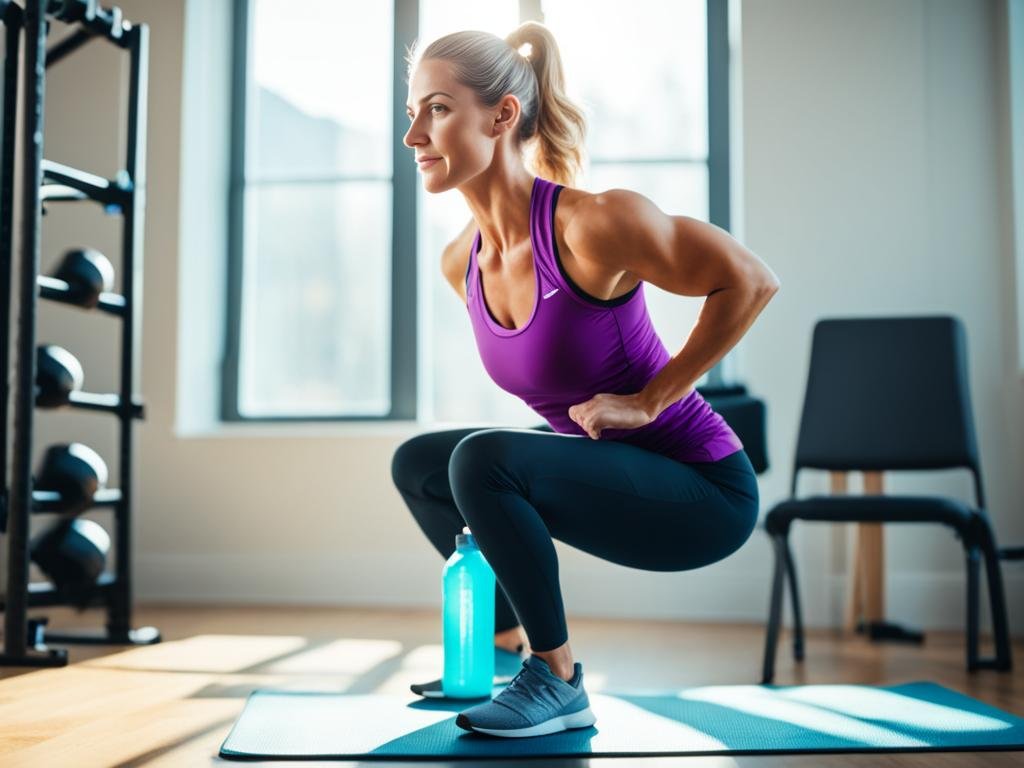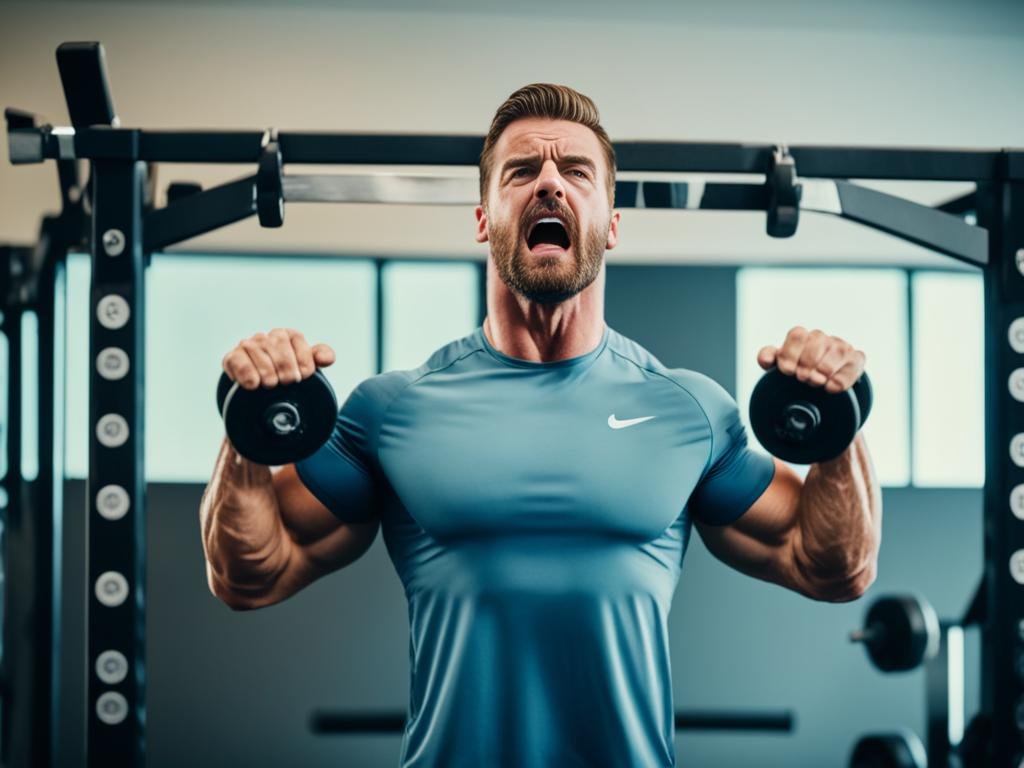Are you ready to take your fitness journey to the next level? Whether you’re just starting out or an experienced gym-goer, finding the right workout routine can be a game-changer. But what if there was a way to create a personalized plan that caters to your unique needs and goals? Unlock the secrets to unlocking your full potential with our comprehensive guide to effective workout routines for every fitness level.
Key Takeaways
- Discover the fundamentals of exercise and how to build a well-rounded fitness regimen.
- Explore beginner, intermediate, and advanced workout plans to suit your current fitness level.
- Understand the importance of incorporating strength training, cardio, and flexibility into your routine.
- Learn about the benefits of high-intensity interval training (HIIT) and bodyweight exercises.
- Develop an effective workout schedule that helps you achieve your weight loss or muscle-building goals.
Understanding the Fundamentals of Exercise
Maintaining a healthy and active lifestyle is essential for overall well-being. At the core of any effective fitness routine are three fundamental components: cardio exercise, strength training, and flexibility and balance. Let’s dive into the importance of each of these elements and how they contribute to a comprehensive exercise program.
Cardio Exercise: A Cornerstone of Fitness
Cardio exercise, also known as aerobic exercise or endurance activity, is the foundation of any fitness regimen. This type of activity raises your heart rate, increases your breathing rate, and engages large muscle groups, leading to improved aerobic fitness and heart health. Engaging in regular cardio exercise can boost your calorie burn, enhance your stamina, and support your overall cardiovascular function.
Common examples of cardio exercise include walking, jogging, cycling, swimming, dancing, and even household chores like raking leaves or shoveling snow. Incorporating cardio exercise into your routine can have a profound impact on your physical and mental well-being.
Strength Training: Building Muscle and Boosting Metabolism
Strength training, also known as resistance training, is another crucial component of a well-rounded fitness program. This type of exercise focuses on building and maintaining muscle mass, which is essential for increasing metabolism and supporting overall physical function. By engaging in strength training exercises, such as weightlifting, bodyweight exercises, or resistance band workouts, you can improve your muscle-building capabilities and enhance your weight management efforts.
Flexibility and Balance: Essential Components
Lastly, flexibility and balance are often overlooked but equally important aspects of a comprehensive fitness program. Flexibility exercises, such as stretching and mobility drills, can improve your range of motion, enhance your posture, and help manage stress and tension. Balance training, on the other hand, can improve your stability and coordination, reducing the risk of falls and injuries, especially for older adults.
Incorporating a mix of cardio exercise, strength training, and flexibility and balance activities into your routine can help you achieve a well-rounded fitness level, promoting overall health and wellness.
Beginner Workout Plan
If you’re new to the world of beginner workouts and starting exercise, it’s essential to ease into a routine that allows your body to adapt gradually. The key to building fitness as a beginner is to start slow and be patient with yourself.
Easing into Exercise
Begin with a simple cardio program and a full-body strength training routine. If that feels like too much, you can start with just the strength training and let that be enough. Many strength training workouts will also increase your heart rate, working your cardiovascular system.
Importance of Rest and Recovery
Remember to prioritize rest and recovery between workouts. A typical beginner program will include two to three days of cardio and two days of strength training, which can be combined if you don’t have five days to devote to exercise. It’s normal to experience some soreness when trying new activities, but if you can’t move the next day, you may have overtrained and need to scale back your next workout.
Allow your body the time it needs to recover and adapt to the new stimulus. Most beginners will start working out at a moderate intensity, which means they’re at about a Level 5 on the perceived exertion scale. Or you can use the talk test: If you can carry on a somewhat breathy conversation while you’re working out, that’s usually a moderate intensity.
“The key to building fitness as a beginner is to start slow and be patient with yourself.”

Intermediate Workout Routines
As you progress in your fitness journey, it’s time to step up your game with intermediate workout routines. These routines are designed to challenge your body and help you see even greater results. Whether your goal is to lose weight, build muscle, or simply improve your overall fitness, these intermediate-level workouts can take your fitness to the next level.
Increasing Intensity and Duration
One of the key aspects of intermediate workouts is the increase in both intensity and duration. This means that you’ll be pushing your body a little harder and for a longer period of time. For example, if your cardio routine used to be 30 minutes, you might now aim for 45-60 minutes. Similarly, your strength training sessions may involve more sets, higher weights, or more challenging exercises.
To maximize the benefits of your intermediate workouts, consider incorporating interval training. This involves alternating periods of high-intensity exercise with periods of lower-intensity recovery. Not only does this boost your cardiovascular fitness, but it can also help with weight loss. Aim to include interval training one or two times per week for best results.
Remember, it’s important to listen to your body and gradually increase the intensity and duration of your workouts. Pushing too hard too fast can lead to injury or burnout, so be patient and focus on steady progress.
“The key to progressing from a beginner to an intermediate exerciser is to gradually increase the intensity and duration of your workouts. This will challenge your body and help you see continued improvements in your fitness level.”
In addition to increased intensity and duration, intermediate workouts may also involve more complex movements or the introduction of new exercises. This variety can help prevent boredom and keep your body adaptable. Remember to always prioritize proper form to avoid injury and get the most out of your workouts.
Advanced Training Programs
If you’ve been consistently exercising for several months and have a good grasp of various fitness activities, you’ve reached the advanced exerciser level. To continue progressing and overcome plateaus, you’ll need to ramp up the intensity and introduce more variety to your workouts. This could involve splitting your strength training routine even further, such as dedicating one day to push exercises and the next to pull exercises.
Advanced exercisers can also incorporate high-intensity interval training (HIIT), high-intensity circuit training, or other challenging techniques to boost calorie burn and build endurance. However, it’s crucial to remember that rest and recovery are just as essential for this fitness level, as excessive intensity can lead to injury, overtraining, and burnout.
Pushing Your Limits Safely
As an advanced exerciser, you have the freedom to experiment with different workout schedules and routines. The key is to mix things up regularly to keep your body guessing and prevent plateaus. Remember, there’s no one-size-fits-all perfect program that works for everyone. Stay flexible and adjust your workouts based on how you’re feeling and what’s happening in your life.
Variety and Progression
- Incorporate high-intensity interval training (HIIT) to challenge your cardiovascular fitness and boost fat-burning.
- Try advanced strength training techniques like supersets, drop sets, or pyramid sets to build muscle and push your limits.
- Vary the exercises, rep ranges, and rest periods in your strength training routine to continually challenge your body.
- Explore new activities like rock climbing, martial arts, or Olympic weightlifting to add excitement and challenge to your regimen.
Remember, the key to success at the advanced level is to stay curious, open-minded, and always strive to improve. By pushing your limits safely and introducing variety, you’ll be able to avoid plateaus and continue making progress on your fitness journey.
“The only way to do great work is to love what you do. If you haven’t found it yet, keep looking. Don’t settle.” – Steve Jobs
Workout Routines for Weight Loss
Achieving sustainable weight loss requires a comprehensive approach that combines effective workout routines with a balanced diet. Whether you’re a beginner or an advanced fitness enthusiast, incorporating the right mix of cardio and strength training can be a game-changer in your weight loss journey.
Cardiovascular exercise, such as brisk walking, jogging, or cycling, is a cornerstone of any weight loss workout plan. Aim for 20 to 60 minutes of moderate-to-vigorous cardio activities 5 or more times per week to maximize calorie burn and fat burning. High-Intensity Interval Training (HIIT) can also be an efficient way to boost your metabolic rate and torch calories in a shorter amount of time.
Complementing your cardio routine with strength training exercises is essential for building lean muscle mass and increasing your overall metabolism. Aim for 2 to 3 strength training sessions per week, focusing on compound movements that engage multiple muscle groups at once, such as squats, deadlifts, and push-ups.
“The key to effective weight loss workouts is to find a balance between cardio and strength training that works for your fitness level and lifestyle.”
Remember, sustainable weight loss ultimately comes down to creating a consistent calorie deficit through a combination of exercise and a balanced, nutrient-dense diet. By incorporating these principles into your weekly routine, you’ll be well on your way to achieving your weight loss goals.

To get started, consider trying one of these effective workout routines for weight loss:
- 20-30 minutes of HIIT followed by 30 minutes of strength training, 3 times per week.
- 45-60 minutes of moderate-intensity cardio, such as brisk walking or cycling, 5 times per week, combined with 2 full-body strength training sessions.
- 30 minutes of cardio, such as swimming or rowing, followed by 30 minutes of bodyweight exercises, 4 times per week.
| Workout Type | Frequency | Duration |
|---|---|---|
| HIIT | 3 times per week | 20-30 minutes |
| Moderate-Intensity Cardio | 5 times per week | 45-60 minutes |
| Cardio + Bodyweight Exercises | 4 times per week | 30 minutes each |
Strength Training Routines
When it comes to building muscle, boosting metabolism, and improving overall fitness, strength training is an essential component. Two common approaches to structuring your strength training workouts are full-body routines and split routines. Both offer unique benefits, and the best option for you will depend on your goals, schedule, and personal preferences.
Full-Body Workouts
Full-body strength training workouts involve targeting all the major muscle groups in a single session. This approach allows you to hit your muscles from multiple angles and provides a comprehensive, whole-body workout. Full-body routines are often preferred by beginners or those with limited time, as they maximize efficiency and ensure balanced development across the body.
Split Routines
In contrast, split routines divide your weight lifting into separate sessions that target specific muscle groups. For example, you might have one day focused on upper-body muscle building, and another day dedicated to lower-body exercises. This approach enables you to dedicate more time and attention to specific areas, allowing for greater intensity and progression.
There is no definitive “best” approach – the optimal choice depends on your individual needs and preferences. Some individuals may find that alternating between full-body and split routines works well, allowing for variety and continued progress. The key is to monitor your progress, adjust your routine as needed, and find the approach that helps you achieve your fitness goals most effectively.
“Consistency is key when it comes to strength training. Choose a routine that you can stick to and adjust it as needed to keep seeing results.”
High-Intensity Interval Training (HIIT)
When it comes to maximizing the benefits of your cardio workouts, High-Intensity Interval Training (HIIT) is a game-changer. This effective technique involves short bursts of intense activity followed by periods of recovery. By alternating between these high-intensity intervals and rest periods, you can stimulate your aerobic system to adapt, ultimately increasing your capacity to burn calories.
The intense intervals during a HIIT workout are designed to boost your metabolism, while the recovery periods allow you to push even harder during the next bout of activity. This dynamic approach can be incorporated into various forms of cardio, from brisk walking to cycling to swimming. By varying the length of the intervals and the work-to-rest ratios, you can tailor the HIIT workout to your fitness level and personal goals.
“HIIT is an incredibly efficient way to improve cardiovascular fitness and burn calories, even long after your workout is finished.”
One of the greatest benefits of HIIT is its ability to deliver impressive results in a relatively short amount of time. The intense bursts of exercise help to maximize calorie burn and metabolic boost, making it an ideal choice for those with busy schedules or limited time for exercise.
If you’re new to HIIT, it’s best to start with guidance from a qualified trainer. They can help you determine the appropriate interval lengths and work-to-rest ratios for your current fitness level, ensuring that you reap the full benefits of this dynamic training approach while avoiding the risk of injury.

By incorporating HIIT into your fitness routine, you’ll not only elevate your cardio performance but also experience a significant boost in your overall calorie burn and metabolic rate. So, if you’re looking to take your workouts to the next level, give HIIT a try and prepare to be amazed by the results.
Bodyweight Exercises
When it comes to building strength, endurance, and overall fitness, bodyweight exercises can be a game-changer. These exercises leverage your own body weight as resistance, making them an accessible and practical option for fitness enthusiasts of all levels. By mastering bodyweight exercises, you can develop the functional fitness that translates to everyday activities and sports.
Squats: The King of Compound Movements
At the heart of any well-rounded bodyweight routine are the mighty squat. As a compound exercise, the squat engages multiple muscle groups in the lower body, including the quadriceps, hamstrings, and glutes. Proper form is crucial to maximize the benefits and avoid injury. Keep your back straight, knees tracking over your toes, and focus on sitting back with your hips as you bend your knees. Start with bodyweight squats and progress to holding weights or using a resistance band for added challenge.
Lunges: Improving Balance and Mobility
Another highly functional bodyweight exercise is the lunge. Lunges mimic the motion of walking, but in an exaggerated way that helps improve balance, stability, and overall lower body mobility. To perform a lunge correctly, take a big step forward, keeping your spine neutral. Bend both knees to 90 degrees, focusing on driving through the heel of your front foot. You can also try lateral and backward lunges to work the muscles from different angles and further enhance your functional fitness.
| Exercise | Primary Muscles Targeted | Benefits |
|---|---|---|
| Squats | Quadriceps, Hamstrings, Glutes | Builds lower body strength, Improves functional movement, Enhances overall fitness |
| Lunges | Quadriceps, Hamstrings, Glutes | Develops balance and stability, Increases lower body mobility, Strengthens functional movement patterns |

By incorporating both squats and lunges into your bodyweight routine, you can unlock the power of compound movements to build a strong, functional, and balanced lower body. These exercises are the foundation of a well-rounded fitness program, helping you move with greater ease and confidence in your daily life and athletic pursuits.
Core and Abdominal Exercises
Developing a strong core is essential for overall fitness, stability, and functional strength. By incorporating core and abdominal exercises into your routine, you can improve posture, reduce the risk of injury, and enhance your performance in a variety of physical activities. Let’s explore some of the most effective core and abdominal exercises that can benefit fitness enthusiasts of all levels.
Planks and Push-Ups
Planks are a fantastic exercise for building core muscle endurance. By holding a push-up position with your body in a straight line, you engage your abdominal, back, and shoulder muscles. Start with a basic plank, and gradually increase the duration as you build strength. Push-ups are another multi-functional exercise that target the chest, shoulders, triceps, and core simultaneously. Maintain a tight, neutral spine throughout the movement, and consider starting with modified push-ups on an incline if the full push-up is too challenging.
Crunches and Oblique Twists
- The classic crunch is an effective way to target the abdominal muscles, but proper form is crucial. Lie on your back with feet flat and fingertips supporting your head. Peel your head, neck, and shoulders off the floor by contracting your abs, being careful not to pull on your neck.
- For oblique work, add a twist as you come up, rotating your torso toward one side. This oblique twist exercise engages the muscles along the sides of your abdomen.
It’s important to remember that crunches alone won’t give you a flat stomach. Reducing body fat through a balanced diet and regular cardio exercise is also necessary for achieving that coveted abdominal definition.
“Developing a strong core is not just about achieving a six-pack. It’s about improving overall stability, balance, and functional strength, which can enhance performance in a wide range of physical activities.”
Proper Form and Technique
Executing exercises with proper form and technique is crucial, regardless of your fitness level. Proper exercise form not only helps you get the most out of each workout, but also plays a vital role in injury prevention and functional fitness. Poor technique can shift the focus of an exercise, putting unnecessary strain on the wrong muscles or joints and increasing the risk of injury.
For beginners, it’s a good idea to work with a qualified trainer to ensure they are performing exercises correctly from the start. Even experienced exercisers should regularly check their exercise form and technique, especially on more complex movements. Maintaining good technique will allow you to train safely and avoid setbacks, while maximizing the benefits of your workouts.
Importance of Proper Technique
Proper exercise form and technique are essential for several reasons:
- Targets the intended muscle groups effectively
- Reduces the risk of injury by avoiding unnecessary strain on joints and muscles
- Allows you to lift heavier weights and progress in your strength training safely
- Improves overall functional fitness and movement patterns
Tips for Maintaining Proper Form
- Start with light weights or bodyweight exercises to focus on technique
- Engage the core and maintain proper alignment throughout each movement
- Slow down the tempo of your lifts to better control the movement
- Ask a certified trainer or experienced gym-goer to provide feedback on your form
- Record yourself performing exercises and review your technique
- Be patient and prioritize proper form over heavier weights or faster reps
By making exercise form and technique a priority, you can maximize the benefits of your workouts while minimizing the risk of injury. Investing the time to perfect your movements will pay off in the long run, helping you progress safely and effectively towards your fitness goals.
| Exercise | Common Form Issues | Tips for Proper Technique |
|---|---|---|
| Squat | Knees tracking inward, back rounding, heels lifting | Engage the core, keep chest up, send hips back, and drive through the heels |
| Deadlift | Rounding the back, lifting with the arms instead of the legs | Maintain a neutral spine, push through the floor with the legs, and keep the bar close to your body |
| Pushup | Sagging hips, flared elbows, not going low enough | Engage the core, tuck the elbows, and lower your chest to the floor |
Conclusion
Developing an effective workout routine that aligns with your fitness level and goals is a transformative step towards improving your health and wellness. By incorporating the key elements of cardio, strength training, flexibility, and balance, you can create a well-rounded program that delivers tangible results.
Remember to start where you are, listen to your body, and be willing to adjust your routine as needed. With consistency and proper technique, you can make steady progress and achieve your fitness aspirations, no matter your starting point. Stay motivated, embrace the journey, and celebrate your victories along the way.
Embrace a holistic approach to fitness that encompasses not just your workout regimen but also a balanced lifestyle. Combine your exercise routine with a nutritious diet, ample rest, and stress management techniques for a truly transformative impact on your overall health and wellbeing.
FAQ
Where should I start if I’m new to exercise?
If you’re new to exercise, it’s best to start slow and ease into a workout routine. Begin with a simple cardio program and a full-body strength training routine. If that’s too much, start with strength training and let that be enough. Remember to rest and recover, as you may need extra recovery days when trying new activities.
How do I structure my workout schedule?
The best workout schedule for you will depend on factors like your age, fitness level, goals, and physical restrictions. A well-rounded program typically includes cardio, strength training, flexibility, and balance work. Most beginner programs include 2-3 days of cardio and 2 days of strength training, which can be combined if you don’t have 5 days to devote to exercise.
What is the difference between cardio and strength training?
Cardio activity, such as walking, jogging, or swimming, raises your heart rate and improves your aerobic fitness. Strength training, using resistance machines, free weights, or bodyweight exercises, builds muscle and boosts your metabolism. Both are essential for overall fitness and health.
How important is flexibility and balance?
Flexibility and balance are important components of physical fitness. Stretching can increase flexibility, improve range of motion, and help reduce stress and tension. Balance exercises are especially important for older adults to prevent falls and fractures, and can also improve stability and core strength.
How do I know if I’m overtraining?
It’s normal to feel some soreness when you start a new exercise routine, but if you can’t move the next day, you may have overdone it. Allow your body time to rest and recover between workouts. Beginners should work at a moderate intensity, where they can still carry on a somewhat breathy conversation.
What is the best way to structure my strength training?
There are different ways to structure your strength training, such as full-body workouts or split routines that target upper and lower body on separate days. Choose what works best for your goals, schedule, and preferences. Monitor your progress and adjust as needed to continue seeing results.
What is High-Intensity Interval Training (HIIT) and how can it help?
HIIT involves short bursts of intense activity followed by periods of recovery. This technique boosts your metabolism and aerobic capacity. HIIT can be incorporated into various forms of cardio to maximize the benefits of your workouts.
What are some effective bodyweight exercises I can do?
Bodyweight exercises like squats, lunges, planks, and push-ups are great for building strength and fitness without equipment. Proper form is key to target the right muscles and avoid injury. Start with bodyweight versions and progress to more challenging variations over time.
How important is proper exercise technique?
Executing exercises with proper form and technique is essential, regardless of your fitness level. Poor form can change the focus of an exercise, put unnecessary strain on joints, and increase the risk of injury. It’s a good idea to work with a qualified trainer, especially as a beginner, to ensure you’re performing exercises correctly.

